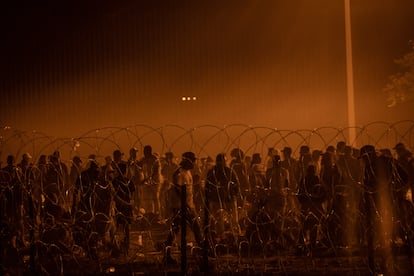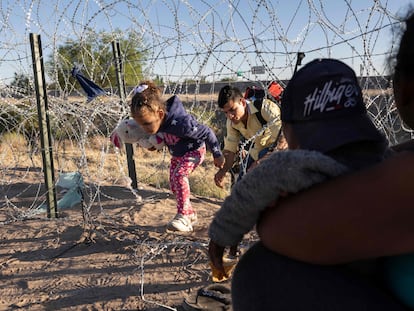Title 42: Keys to understanding the ‘anti-migrant’ measure
With the end of Title 42, we explain how the program was used to deny entry to asylum seekers and migrants, and what will happen after it expires

As the Biden administration is ending the Covid public health emergency, Title 42′s border restrictions are coming to an end too. This order, issued by the U.S. Centers for Disease Control and Prevention under the Trump administration allowed authorities to expel migrants at the borders without giving them the opportunity to present a case based on the public health risk posed by Covid-19.
The policy is set to end at 11:59 pm ET on Thursday, May 11, and the U.S. is expecting a significant increase in the number of migrants trying to cross into the country. The Biden administration is preparing for this by setting up additional facilities along the border to process migrants and relying on a fast-track deportation process known as “expedited removal”. It has also issued a new regulation that would ban migrants who traveled through other countries on their way to the U.S-Mexico border from applying for asylum.
What is Title 42?
Title 42 of the United States Code deals with public health, social welfare and civil rights. It includes laws related to Child Nutrition, Social Security, Civil Rights, Air Pollution Control, and others.
In 1944, as part of the Public Health Service Act, a provision called “Suspension of entries and imports from designated places to prevent spread of communicable diseases” was implemented. It states that if there’s a communicable disease in a foreign country, the Surgeon General “shall have the power to prohibit, in whole or in part, the introduction of persons and property from such countries or places [...] to avert such danger”.

It was implemented under the Donald Trump administration during the Covid-19 pandemic in March, 2020. Stephen Miller, a Trump Advisor, had a role in shaping the policy. The CDC issued a public health order allowing for the rapid expulsion of unauthorized migrants and asylum seekers, citing health concerns. Several public health officials, including Anne Schuchat, the second-highest official at the CDC, pushed back on this policy and argued that there is no public health benefit to Title 42. Since it is considered an “expulsion” rather than a normal deportation, migrants do not have the right to make a case to stay in the U.S. before an immigration judge, and most of them are returned to Mexico within hours.
Title 42 on unaccompanied children
In November 2020, a federal court ordered a halt to the practice of expelling unaccompanied minor children, but on January 29, 2021, the DC Circuit Court of Appeals lifted the stay, allowing minors to be expelled once again. Oh March 14, 2022, the Biden administration decided that unaccompanied children are exempt from Title 42.
Children who cross the border alone are often picked up by Customs and Border Protection, processed, and then moved into the Office of Refugee Resettlement shelters. Upon release to their sponsors, they are provided with documents related to their case and can try to seek asylum or other forms of relief.
In February 2021, Mexico stopped accepting families with children under the program and non-Mexican family units with minor children.

Title 42 under Biden Administration
In June 2021, it was reported that the Biden administration may be considering rescinding Title 42. But in September, NPR reported that the government was defending the program under the pretext of slowing the spread of Covid-19.
In March, 2022, the DC Circuit Court of Appeals ruled that the administration can continue to remove migrant families, but “only to places where they will not be persecuted or tortured”.
On April 1, 2022, the CDC announced they would rescind Title 42, but it was not scheduled to officially end until May 23, 2022. However, on May 20, Robert R. Summerhays, federal judge for the United States District Court for the Western District of Louisiana, issued a ruling blocking the CDC from ending Title 42 expulsion. In October 2022, the administration used Title 42 to expel Venezuelan migrants back to Mexico, a decision that was criticized by Amnesty International and Human Rights Watch.
On November 16, 2022, a federal judge in the U.S. gave the Biden administration five weeks to end Title 42, but on December, 21, 2022, the Supreme Court decided that Title 42 would remain in place.

When does Title 42 expire?
Title 42 is expected to end on May 11, when the Covid-19 public health emergency ends. After the expiration, the Biden Administration intends to reinforce the number of troops deployed at the U.S.-Mexico border. Representatives Thom Tillis and Krysten Sinema introduced a bipartisan bill to extend the program.
During a meeting between Joe Biden and Mexico’s President Andres Manuel López Obrador, they discussed close coordination between border authorities and strong measures (to enforce the border) in preparation for a return to Title 8, which entails harsher consequences for those removed than for those who have been removed under Title 42.
Biden and López Obrador stressed the value of migration management “in a humane and orderly manner, with expanded legal avenues and consequences for irregular migration.”
What happens when Title 42 expires?
U.S. officials are preparing for a surge of migrants attempting to cross the U.S.-Mexico border illegally, with arrivals expected to surpass 10,000 per day as of the expiration. The U.S. will resume a policy of screening asylum applications and deporting those who do not qualify. It also has implemented new measures to speed up the process, including screening applicants within 24 hours and deporting them within days or weeks. Those who are caught crossing illegally and deported will be prohibited from re-entering the U.S. for at least five years and could be ineligible for asylum.
On May 2, 2023, an agreement was reached in which Mexico has agreed to accept 30,000 migrants per month from Cuba, Haiti, Nicaragua, and Venezuela. In exchange, the U.S. has agreed to accept up to 100,000 individuals from Honduras, Guatemala, and El Salvador who have family in the U.S..
Sign up for our weekly newsletter to get more English-language news coverage from EL PAÍS USA Edition
Tu suscripción se está usando en otro dispositivo
¿Quieres añadir otro usuario a tu suscripción?
Si continúas leyendo en este dispositivo, no se podrá leer en el otro.
FlechaTu suscripción se está usando en otro dispositivo y solo puedes acceder a EL PAÍS desde un dispositivo a la vez.
Si quieres compartir tu cuenta, cambia tu suscripción a la modalidad Premium, así podrás añadir otro usuario. Cada uno accederá con su propia cuenta de email, lo que os permitirá personalizar vuestra experiencia en EL PAÍS.
¿Tienes una suscripción de empresa? Accede aquí para contratar más cuentas.
En el caso de no saber quién está usando tu cuenta, te recomendamos cambiar tu contraseña aquí.
Si decides continuar compartiendo tu cuenta, este mensaje se mostrará en tu dispositivo y en el de la otra persona que está usando tu cuenta de forma indefinida, afectando a tu experiencia de lectura. Puedes consultar aquí los términos y condiciones de la suscripción digital.
More information
Archived In
Últimas noticias
Raúl Rocha, from jet-setting with Miss Universe to arms trafficking and fuel theft
80,000 barrels of Mexican oil sent to Cuba: Havana drawn into the US–Mexico clash
Human rights activists, opposition members, and a minor: Maduro’s other political prisoners
Israel sparks a civil war within the MAGA movement
Most viewed
- Reinhard Genzel, Nobel laureate in physics: ‘One-minute videos will never give you the truth’
- Pablo Escobar’s hippos: A serious environmental problem, 40 years on
- Charles Dubouloz, mountaineering star, retires at 36 with a farewell tour inspired by Walter Bonatti
- Why we lost the habit of sleeping in two segments and how that changed our sense of time
- The Florida Keys tourist paradise is besieged by immigration agents: ‘We’ve never seen anything like this’











































